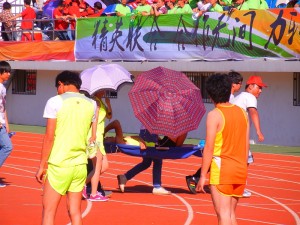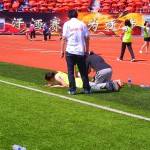Part 1 of this piece, a rundown of a track and field meet in a Chinese university, can be read here. It ended with the writer noticing more people out for a run at his campus’s outdoor stadium:
…I liked the athletic company, though there were nearly always as many walkers as runners, and some of the runners looked pretty grim about the whole thing. On the day of the meet, I saw why their training looked so dour. They weren’t exactly staring death in the face, but perhaps they couldn’t help but notice his pimply younger brother.
My feelings careened all over the emotional map during the women’s 3000-metre race. It was glorious, pathetic, dramatic, and a complete mess. (So was I, by the end.) Contrary to all the rules of track competition, many of the schools had conscripted a young man to run alongside their female entrant, while others had a relay team taking one or two hundred-metre turns urging the runners on and charging pell-mell across the infield. Some of the go-go girls carried water bottles, and would fling handfuls at the faces of their favourite athlete on this warm day. Some competitors plodded drearily, hands on exhausted hips. There were two heats of this spectacular struggle session, so as the lead runner was heading for the home stretch, she lengthened her stride trying to achieve a winning time. A dozen young men ran with her, just inside the infield, occasionally barrelling over a race marshal or spectator. Her desperate effort across the last hundred metres had me choked with admiring emotion. The glory of sport! Even here! What a noble effort! But as I moved closer to the finish line, I saw a growing collection of young women, dazed and prone, or in a couple of photogenic cases (but sorry, no photo!) a limp body being carried in the arms of a young Galahad towards a patch of shade. Anxious teams of friends and first-aid volunteers (with no training) fanned and flung water in a flurry of urgent and useless ministrations to fallen warriors. That’s when I started to get angry.
Physical education programs are neglected routinely all over China. Yao Ming, the retired basketball star, has implored Party officials to preserve or restore such activity, but insane academic pressure among urban parents (coupled weirdly with paranoid pampering of the one-child policy’s princes and princesses) compromises all attempts to encourage sport for the health of the masses. And kids have died in these competitions, competing in an emotional din far beyond the level of their preparation, and this has prompted calls to ban them. At the finish line, all these ill-prepared young women – forced to run by self-serving, face-seeking college mentors; cajoled by the mobile pep squad of harpies at their left shoulder; and, suddenly driven by the roar of thousands to give their all to an activity that

One of the liveliest and best-dressed student sections. Jia you! Jia you! (“Add oil!”, the preferred Chinese expression for “go, team, go!”)
is blandly ignored, even discouraged, on the other 364 days of the year – gasped and blacked out and lay limply on the lovely green turf. I was outraged. JP, a veteran of this circus, was more sanguine about it than I was.
“There’s a lot of drama there, too,” he said as we watched later races together. Yes, it’s ridiculous to run so hard with so little training or fitness, and yes, there’s a lot of pressure, but that wasn’t the whole story, JP figured. “They love to be the centre of attention, you know. Look at all the boys around them. Once, I walked into a group crowded around a girl after a race. I said, ‘I’m a doctor!’ You’d have thought the kid was dying. I looked her over quickly, and said, ‘You’re fine. You can get up now.’” Ah. I could see that, too. It made me think of the old “damsels in distress” and “rescuing the fair maiden” tropes that once were so common in Western culture, and in my own childhood. (I remember a cartoon with the evil “Snidely Whiplash”, and helpless young women tied to railway tracks, and “Dudley Do-Right” and his heroic chin saving them at the last moment.) We don’t think of young women this way so much anymore, but this (possibly) patronizing attitude is not only current but encouraged in China. Most girls hope for someone who will protect them, a shoulder to lean on, and for someone to carry for them their tiny but apparently weighty purses and parasols. JP and I argued about drama versus distress and the relative importance of each, but once I had given up stomping about in indignation, I conceded his point, to a degree.
That didn’t help me much at the women’s long jump, though. JP was at the other end watching the shot-put show when I wandered toward the pits. As I came closer, I started noticing little knots of people spread all around one side of the long jump area, and each of these collections had a moaning girl at the centre. The sand in the pits, of course, was damp and hard after being covered for months, and nobody had dug it up. The board was three metres from the pit, and many of the girls couldn’t jump that far. Worse, the end of the rubberized runway was exposed; the sand should have at or slightly above the level of the runway, but instead was several inches below it. A hard, right-angled mini-cliff greeted the majority of the jumpers.
Of the 28 kids in the competition, probably a dozen had clipped the edge of the pit with their heels and/or jolted their lower legs landing in an unforgiving mass of cemented sand. Maybe it was my history of basketball-induced ankle sprains that made me so sensitive, but I flung my water bottle in useless rage. I wanted to shout (incoherently, of course) at the careless, chain-smoking event official under his patio umbrella, fatly looking on as girl after girl was carried out of the pit. Rake the sand properly? Make a temporary take-off mark
that was closer to the pit? Not his job. Not anybody’s, apparently, though JP and I debated the merits of applying for “Ugly Canadian” status by grabbing the shovels and rakes from the hapless students leaning on them, and doing a little unsolicited (and likely incomprehensible) earth-moving. It’s not easy for fiery sports-lovers in China to pick their battles wisely, but we managed to stay out of the fray that time.
My field-event frustrations needed some tempering, some good old-fashioned see-the-good gratitude. (But before we get to that, JP’s predictions about the “cripple jump”, as he insisted on calling it, held true. Only about five out of 30 boys made it as far as the sand pit in

The impossible triple jump dream. JP once blandly told a “coach” who was demonstrating the TJ, “You won’t make it to the pit,” and was proved right two blustering attempts and a cold shoulder later. “How did you *know*?” asked an astonished student onlooker. Experience.
their three jumps, but there was one young antelope, the same lad who won the long jump, who broke the school record by jumping 13.92 metres, about the same distance JP used to hit in his university days. For reference, the record for 15-and-under boys in Ontario is a longstanding one, at 14.17 m.) Back to the silver lining patrol: yes, I should have been more positive. At least there was no women’s triple jump. There was no discus, no javelin, no pole vault, heaven help us! In the calm of my writing room, I can thank all good things that they don’t try to have their kids run the hurdles, though world champion Liu Xiang was a national hero until his Olympic failures. I giggle a little just imagining the horror show of hurdles.
And still, for old sports hounds like us, there is great pleasure in watching athletes, and there were some, however under-trained they might be. JP, especially, thrilled to a young man or woman with the easy, powerful stride of a natural runner, and he seemed less inclined than I am to fuss and lament that she or he had never had the chance to really enjoy and express this athletic gift. (“At least we two have had today,” as the poet Sara Teasdale1 once wrote of one golden day under a different sun.) On top of that, relay races are exciting however they’re run, especially when 8000 students get revved up, and they did. The 4X100-metre and 4X400-metre races – not just for students, either, but for staff members as well, though the entry invitation never came to the foreign teachers (not that I’m bitter!) – were the usual highlights of the meet, but there were some unusual ones, too.
Some races came “with abundant Chinese characteristics”. I give you: the 8X200-metres mixed relay! My favourite one, just for the excited strangeness of it all and the non-stop roaring of the crowd, took us a few minutes of rehash and post-race inquiry just to figure out what it was: the 3050-Metre Alternating-Gender and Varying-Distance Relay! It was a hoot and a wonderment. A girl ran 50 metres, passed the baton to a 100-metre boy, then came a pair of 200-metre legs, a couple of fours, and finally a brace of 800-metre runs. It was an odd relay for being more exciting at the beginning than at the end, since the longer distances stretched out the field, but still: there’s something you don’t see every day! The whole day was full of ’em. (Full disclosure: I didn’t make it back for the Friday morning conclusion, but JP filled me in on the highlights.)
As JP pointed out, with a few exceptions – “in triple jump, and some others, the top kids were at the provincial level for track in Ontario, though not in medal territory”2 – the athletes were mainly equivalent to a high school intramural meet back home (and in some cases, an elementary school’s field day). These students, after a high school career drained of fun and excitement (but also of drugs, cliques and broken hearts – intimate relationships are forbidden), are doing their dazed and bloody best to bring some colour to their university lives. Many of the conscripted “fans” were bored silly, resentful of “toilet passes” (six, for our college’s hundreds of volun-told spectators), and wishing they could be anywhere other than a sun-bleached plastic seat for a day and a half of closely monitored watching (or not). Others, though, seemed to genuinely get into the spirit of the event, cheering their competitors with a wonderfully naïve kind of unblushing enthusiasm. There were entire student sections that seemed unrelenting in their jia you, go-team-go spirit. I loved that part.
There’s an old saying about baseball: It MUST be a great game to survive the idiots that run it! That’s a stab at short-sighted major league baseball owners and administrators, and it comes to mind in the aftermath of Sports Day. A disspiritingly high proportion of the reason for the event, it seems to me, is not for the athletes at all. There is college pride, of course, and the wisdom of letting students have a small sporting carrot to look forward to, and a chance for them to blow off steam. However, there is also the tendency – much more blatant, to my eyes at least, here than in North America – for an event or activity to hinge on how good it makes an official look. Face and prestige and status are ever-present undercurrents in Chinese life, and sometimes they appear to swamp the boat completely. And yet, sport survives, and more. No matter how much it is used for purposes other than delight, other than camaraderie and the challenge of personal excellence, athletics in the long run (pun intended!) still manages to rise above the muck. Kids raced and leaped like it mattered, and that never fails to move my heart.
Running and jumping and joy, oh my! But it does get better than this, and it’s one of the small but poignant pities of my little life here that these kids don’t get it, though the mixed blessing of a Show Meet like this is something that their country cousins and teenaged factory workers would likely envy. And it wakened my love, usually only experienced on TV every Olympic quadrennial, for the elemental glories of track and field: so simple, so timeless, and so much better when the athletes can run ’cause they want to.

The colour and the spirits were high and bright as we opened the meet. It was a spectacular show, and occasionally the sporting moments were, too. Photo: J.P. Mayer
1 And hey, call me a flaming fount of idiotic footnoting and general lunacy — you wouldn’t be the first! — but I just made references to classic poetry and bad 1960s Canadian animation in a post on track and field! I am a proud man.
2 For reference, here are some of the results from the meet, with the winning time/distance from the Ontario Federation of School Athletic Associations (OFSAA) high school meet back home in brackets (the winning time comes from the “Midget” designation, mainly ninth-graders; still, this is a major T&F festival, which has produced many Canadian Olympians). Girls: 100m 13.1 s (OFSAA Midget winner 12.21); 200m 28.81 (25.11); 400m 1:06.70 (54.63, an OFSAA record, mind you, by the same girl that won the 100 and 200 metre races with ease – Canadian Olympian Alert for Kyra Constantine!); 800m 2:42.09 (2:11.76); 1500 5:48:16 (4:28.41, another OFSAA record); 3000 12:40 (9:53.86); High Jump 1.37 m (1.58); Long Jump 4.56 m (5.38); Shot put 9.39 m (10.41). Boys: 100m 11.20 s (OFSAA Midget winner 11.17 s); 200m 24.20 (23.39); 400m 54.20 (51.27); 800m 2:09:54 (1:58.19); 1500m 4:42.39 (4:03.40); HJ 1.78 m (1.86); LJ 6.60 m (6.24; senior (17-18 year-old) boys was 7.08); TJ 13.92 m (12.78; senior boys was 14.47) ; Shot 11.01 (OFSAA 15.88).
Random footnote observations: the boys in a Chinese university are much more competitive with Canadian track results than are the girls, especially in the pure speed/jumping events. As the distances mount, the lack of training sets in more clearly. The lad who won LJ and TJ at my university, and the guy who won the 100 metres, can really go. They’d have been pretty fine competitors with earlier opportunities. Mind you, I have heard a suggestion that some of our school’s best are “ringers”, admitted from a specialized sport school to make our school look good. I can’t confirm it, but I do know our school admits unqualified students from a basketball-centric State school, winning a local bush-league title this year. Apparently they are trying to join the CUBA (see footnote early in Part 1).



This is a late comment, but one I wanted to make. “Most girls hope for someone who will protect them, a shoulder to lean on, and for someone to carry for them their tiny but apparently weighty purses and parasols.” [citation needed]
If you put an unsubstantiated claim into a Wikipedia page, someone editing the article can put a little ‘[citation needed]’ tag on there to show where work needs to be done.
It’s my snarky way of saying that the casual observances of anyone, especially a man, of what “most girls hope”, or feel, or want, especially when it conforms neatly to old gender norm chestnuts, don’t really count.
Unless of course it wasn’t just your opinion and you have a dynamite source or two with clear conclusions and unquestionable methodology that says the same thing. In which case, citation needed.